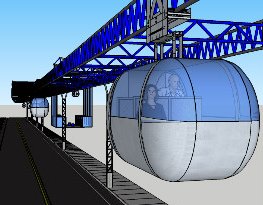CityTram
A new vision in urban commuting
A better way
to get from here to there
(faster and cheaper, reliably and safely)
Concept What is this new vision? How does it differ from mass transit ?
CABLE/CHAIN DRIVE
CityTram is unique among ATN systems in its use of mechanical drive. Other ATN systems use electrically driven vehicles. The use of mechanical drive is largely responsible for the construction cost advantage of CityTram over other ATN systems.
Since most of the cost of these systems is in the guideway and its elevation, minimizing that cost is critical! The electric motor used in the cars for other ATN systems must be powerful enough to accelerate the vehicles, and to drive them up any hills they may encounter. So the motor in all vehicles must be sized in light of the steepest hill in the network. These motors alone can weigh hundreds of pounds. In some systems the cars also require a substantial battery, which adds additional weight. All guideway bridges must then be designed strong enough to support a line of these heavy vehicles traversing the middle of the bridge. This means stronger and heavier structural members, and bigger structures. And since the bridges must also support their own weight, this has a more than linear impact at driving up the structure costs.
The passive vehicles of CityTram do not have to carry this extra weight. The electric motors are located near the support towers. Their pushing effect is extended out over the bridges using a lightweight system of cables and pulleys or chains and sprockets. Further, this mechanical pusher mechanism maintains a minimum spacing between vehicles. This enhances safety. But it also limits worst case bridge loading. Each electric motor drives a pusher loop which is limited in span to a local segment of the track. Cars are passed from one pusher loop to the next as they advance down the track. CityTram control operates all vehicles at a constant velocity, so no acceleration power is needed. Therefore 5 HP is all that is needed to maintain the velocity of a single car (even against a 50 MPH headwind). So very small motors are used, which are installed at fixed sites served with electricity. This avoids safety issues and distribution losses which would be associated with getting electricity to moving vehicles. Where hills exist, larger motors are used only on those pusher loops that climb the hills (rather than all across the system).
The particulars of the drive mechanism and the control mechanism are not disclosed on this site, as they are considered intellectual property, and are in the patent process.
